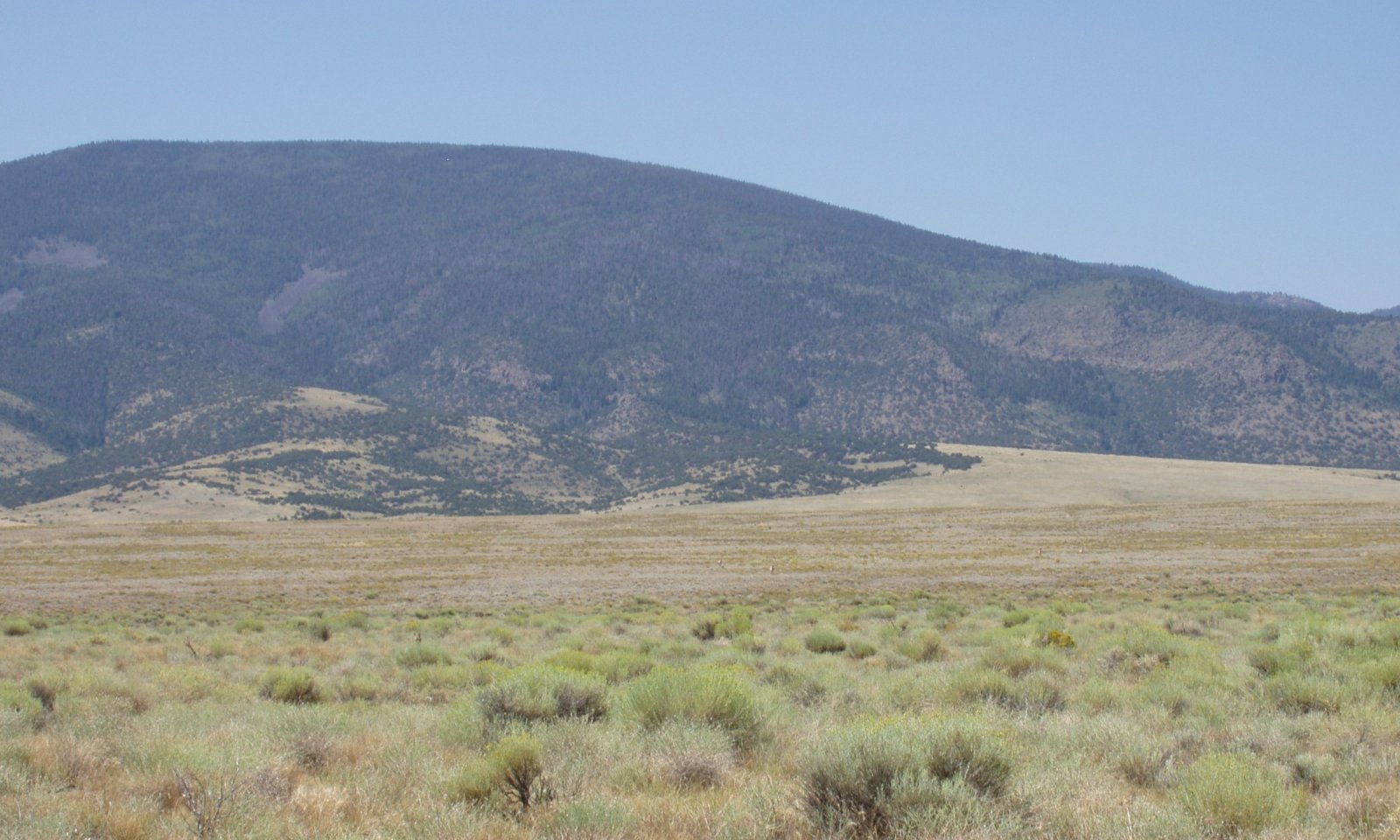

Natural Resources
Conservation Service
Ecological site R051XY281CO
Mountain Outwash
Last updated: 12/11/2024
Accessed: 12/21/2025
General information
Provisional. A provisional ecological site description has undergone quality control and quality assurance review. It contains a working state and transition model and enough information to identify the ecological site.
MLRA notes
Major Land Resource Area (MLRA): 051X–High Intermountain Valleys
This MLRA encompasses the San Luis Valley in south central Colorado and the Taos Plateau and Taos alluvial fans of north central New Mexico. As part of the northern portion of the Rio Grande Rift, the MLRA consists of large, alluvium filled basins washed down from adjacent mountain ranges. The Rio Grande River flows through this MLRA, continuing its long function of carrying mountain sediment down to the basin. Cenozoic volcanism is an extensive characteristic of the MLRA where large basalt flows with volcanic hills and domes are abundant. Ancient Lake Alamosa is a large feature within the MLRA..
Ecological site concept
The soils are derived from alluvium from mostly metamorphic and igneous sources. The soils have a range from loam to sandy loam over skeletal layers of gravel and cobble. The soils may have accumulated carbonates in the B horizon but not to the extent that defines the limy bench site. Soils are are often skeletal throughout the profile, are rapidly drained and have low water-storage capacity. Blue grama is usually the most abundant grass, but taller grasses, mostly cool-season species make up a significant part of the annual production.
Associated sites
| R051XY277CO |
Basalt Hill 7-12 PZ Basalt hills are associated with basalt flows that are adjacent and surrounded by the fans of the mountain outwash. |
|---|---|
| R051XY276CO |
Limy Bench The Mountain Outwash site occupies similar landforms as the limy bench but does not have as much accumulated CaCo3 in the B horizon. The limy bench will have masses and sometimes nodules of CaCo3 near the surface which promotes winterfat dominance. |
| R051XY273CO |
Sandy Bench The Sandy Bench site has non-skeletal, courser soils. The particle size class is normally course-loamy. The sandy bench also has a calcic diagnostic horizon while the Mountain Outwash does not. |
| R051XY233CO |
Mountain Loam 10-18 PZ The Mountain Loam site occurs in the mixed conifer zone of the bounding mountains. The site occurs at the lower slopes of the mountain base, consisting of the lower colluvial apron, mountain valley fans, and terraces of drainages. Elevation ranges from 8200 feet to 9500 feet. Soils are formed from colluvium and alluvium derived from igneous rock. Soils are very deep and surface textures range from loam to sandy loam. |
| R051XY286CO |
Rocky Foothills Parent materials are mostly residuum with some colluvium and alluvium, derived from andesite and rhyolite. Soils are shallow. Areas of rock outcrop are scattered throughout. Elevation ranges from 8000 to 9500 feet. Slope position is variable from summit positions to back slopes. The soils are loamy-skeletal with the presence of rocks, cobbles, and stones throughout. |
Similar sites
| R051XY286CO |
Rocky Foothills Parent materials are mostly residuum with some colluvium and alluvium, derived from andesite and rhyolite. Soils are shallow. Areas of rock outcrop are scattered throughout. Elevation ranges from 8000 to 9500 feet. Slope position is variable from summit positions to back slopes. The soils are loamy-skeletal with the presence of rocks, cobbles, and stones throughout. |
|---|
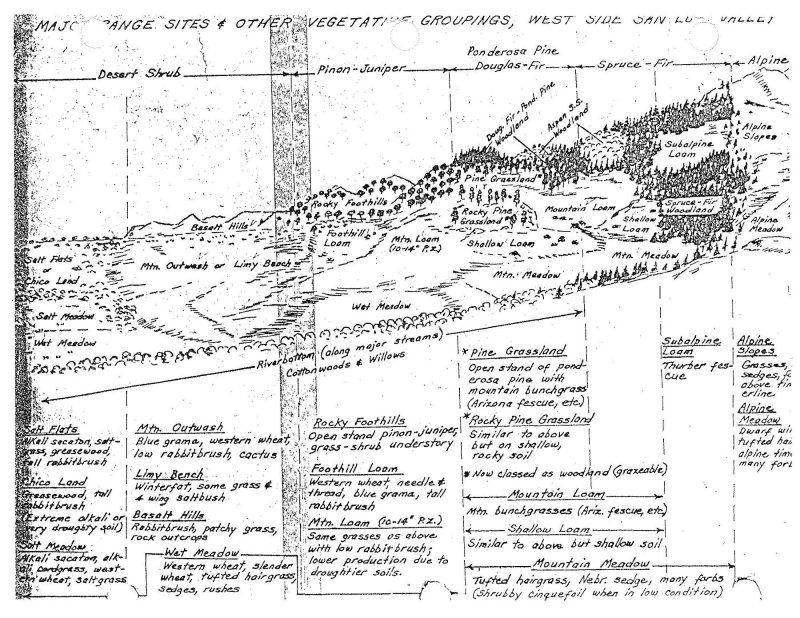
Figure 1.
Table 1. Dominant plant species
| Tree |
Not specified |
|---|---|
| Shrub |
Not specified |
| Herbaceous |
(1) Bouteloua gracilis |
Physiographic features
This site occupies broad alluvial fans formed by outwash from high mountain ranges. In many places, the fans have coalesced to form a smooth plain that feathers out to a flat valley floor. In some places, they form low benches or terraces above stream courses. There are some minor undulations caused by small drainageways, but most of the site has smooth topography.
Table 2. Representative physiographic features
| Landforms |
(1)
Alluvial fan
(2) Fan (3) Terrace |
|---|---|
| Runoff class | Very low to medium |
| Flooding frequency | None |
| Ponding frequency | None |
| Elevation | 7,500 – 8,300 ft |
| Slope | 1 – 10% |
| Aspect | Aspect is not a significant factor |
Climatic features
The climate that typifies the High Intermountain Valley, ranges from arid to semi-arid, and is characterized by cold winters, moderate summers, and much sunshine. Average annual precipitation ranges from 7 to 10 inches along the valley floor and throughout most of the resource area. Approximately 55 percent of the annual precipitation falls between May 1 and September 1. May and June are normally dry. Precipitation comes mostly from short duration high intensity thundershowers in July and August. Wide seasonal and yearly variations are common. The San Juan mountain range to the west and the Sangre de Cristo Mountains to the east intercept much of the precipitation causing a two-way rain shadow effect. Most major plant species initiate growth between mid May and late July, but growth may extend into September. Some cool season plants begin growth earlier and complete growth by mid June. There may be late re-growth on some of the plants.
Cold air from the encompassing mountain ranges drain into the valley and settle. This phenomena results in long cold winters and moderate summer temperatures. Mean average annual temperature ranges between 42 to 44 degrees F. July is the hottest month and January is the coldest. Summer temperatures range from highs in the upper 70’s and low 80’s and occasionally reach to the mid 90 degrees F. Summer nights are cool. Temperatures of -20 degrees F to -30 degrees F can be expected each year and are common during some winters. Average frost-free period is 90-115 days, from late May or early June to September.
Wind that often reaches high velocities are common, especially in the spring. Relative humidity is usually low. Even so, evaporation rates average lower than those of many dry regions because of the cooler climate. Snow cover is often light and is sometimes lacking through much of the winter. There is usually some snow, though, during the coldest weather.
Table 3. Representative climatic features
| Frost-free period (characteristic range) | 75-83 days |
|---|---|
| Freeze-free period (characteristic range) | 95-104 days |
| Precipitation total (characteristic range) | 7-9 in |
| Frost-free period (actual range) | 70-83 days |
| Freeze-free period (actual range) | 94-107 days |
| Precipitation total (actual range) | 7-9 in |
| Frost-free period (average) | 78 days |
| Freeze-free period (average) | 100 days |
| Precipitation total (average) | 8 in |
Figure 2. Monthly precipitation range
Figure 3. Monthly minimum temperature range
Figure 4. Monthly maximum temperature range
Figure 5. Monthly average minimum and maximum temperature
Figure 6. Annual precipitation pattern
Figure 7. Annual average temperature pattern
Climate stations used
-
(1) ALAMOSA SAN LUIS AP [USW00023061], Alamosa, CO
-
(2) CENTER 4 SSW [USC00051458], Center, CO
-
(3) MANASSA [USC00055322], La Jara, CO
Influencing water features
This site does not have a water table.
Soil features
Soil surface horizons range from 12 to 20% clay content with the most common surface textures being gravelly sandy loam, cobbly sandy loam, very gravelly sandy loam, very gravelly loam, and cobbly loam. Surface horizons are over skeletal horizons heavy in gravel and/or cobble. The subsurface clay content at 20 inches can range from 12 to 25% clay.
These soils are rapidly drained and have a low water-storage capacity. But moisture retention is low, allowing plants access to available moisture.
Typical soils correlated to this site are:
Derrick, Dunul, Quamon and Saguache.
Table 4. Representative soil features
| Parent material |
(1)
Alluvium
|
|---|---|
| Surface texture |
(1) Gravelly, cobbly, very gravelly sandy loam (2) Very gravelly, cobbly loam |
| Family particle size |
(1) Loamy-skeletal (2) Sandy-skeletal |
| Drainage class | Moderately well drained to somewhat excessively drained |
| Permeability class | Moderately slow to rapid |
| Soil depth | 60 in |
| Surface fragment cover <=3" | 15 – 35% |
| Surface fragment cover >3" | 5 – 25% |
| Available water capacity (Depth not specified) |
1 – 3 in |
| Calcium carbonate equivalent (Depth not specified) |
10% |
| Electrical conductivity (Depth not specified) |
2 mmhos/cm |
| Sodium adsorption ratio (Depth not specified) |
5 |
| Soil reaction (1:1 water) (Depth not specified) |
6.6 – 8.4 |
| Subsurface fragment volume <=3" (Depth not specified) |
20 – 55% |
| Subsurface fragment volume >3" (Depth not specified) |
5 – 35% |
Ecological dynamics
This site exists on the same land forms as the limy bench. The difference is that the limy bench has a Bk horizon with masses or nodules of accumulated CaCo3. This calcareous layer favors winterfat. The mountain outwash site has the look of a fairly uniform stand of grass with a few low shrubs. Blue grama is usually the most abundant grass. But taller grasses, mostly cool-season species, make up a significant part of the annual production. Of these, squirreltail, western wheatgrass, and Indian ricegrass are most important. There are usually small amounts of needle-and-thread, sand dropseed, purple threeawn, and needleleaf sedge, along with a few forbs such as scarlet globemallow, eriogonum, senecio, locoweed, evening primrose, and paintbrush. Scattered shrubs include winterfat, Greene's rabbitbrush, pricklypear, fringed sage, smooth horsebrush, snakeweed, and yucca.
Site degradation due to excessive grazing pressure will cause the site to change in species composition. Initially, western wheatgrass, winterfat, and fourwing saltbush will decerase while species with more grazing defenses such as blue grama and Greene’s rabbitbrush will gain a competitive advantage. If the excessive grazing pressure continues long term and drives the site across a threshold, important cool season grasses such as Indian ricegrass and needleandthread will be lost. A site that has lost soil and has crossed a threshold will exhibit bare areas with a few hardy species such as Bottlebrush squirreltail, rabbitbrush, low vigor blue grama, ring muhly, and scattered annuals.
State and transition model
More interactive model formats are also available.
View Interactive Models
Click on state and transition labels to scroll to the respective text
Ecosystem states
State 1 submodel, plant communities
State 2 submodel, plant communities
State 1
Reference

Figure 8. Mountain Outwash site showing a mix of grass, forbs and shrubs.
The reference state has a mix of grasses, forbs and shrubs. Bare ground is minimal and ecological services are maximized. The mix between cool and warm season grasses is about equal, allowing for continued plant growth through the late spring, summer, and into the early fall. This site also has a diverse mix of forbs and shrubs, including some cactus.
Resilience management. The reference state has a large diversity of grasses, forbs, and shrubs which provide a host of ecosystem services that maintain soil stability, biotic integrity, and hydrologic function. This state is the most capable to withstand disturbance.
Community 1.1
Grass, Shrub, and Forb Mix

Figure 9. Reference community in the foreground
The structural-functional groups fall as 45-60% grasses and grass-like plants, 5-10% forbs, and 35-45% shrubs. The dominant grasses are western wheatgrass and blue grama. Sub-dominant grasses include Indian ricegrass, needleandthread, bottlebrush squirreltail, sand dropseed, and threeawn. Significant forbs include scarlet globemallow, Colorado four o’clock, crownleaf evening-primrose, eriogonum, penstemon, stoneseed, and ragwort species. Winterfat and fourwing saltbush are the dominant shrubs. Other shrubs include Greene’s rabbitbrush, rubber rabbitbrush, broom snakeweed, skunkbush sumac, plains pricklypear, and small soapweed. Skunkbush sumac tends to occupy areas near stream courses where an upstream seed source exists.
Resilience management. The reference community phase has the highest level of resilience to disturbance. It has the greatest diversity of plants that contribute to a host of ecological processes. This site has the best ability to withstand drought and take advantage of moisture that falls throughout the spring, summer, and early fall.
Dominant plant species
-
fourwing saltbush (Atriplex canescens), shrub
-
rubber rabbitbrush (Ericameria nauseosa), shrub
-
blue grama (Bouteloua gracilis), grass
-
western wheatgrass (Pascopyrum smithii), grass
Figure 10. Annual production by plant type (representative values) or group (midpoint values)
Table 5. Annual production by plant type
| Plant type | Low (lb/acre) |
Representative value (lb/acre) |
High (lb/acre) |
|---|---|---|---|
| Grass/Grasslike | 210 | 420 | 560 |
| Shrub/Vine | 60 | 120 | 160 |
| Forb | 30 | 60 | 80 |
| Total | 300 | 600 | 800 |
Figure 11. Plant community growth curve (percent production by month). CO5109, Cool-season/Warm-season co-dominant, coarse textured soils, alluvial fans and benches. Located in LRU 51-5 on fans and fan remnants above valley floor, pre-dominantly in Saguache County, Villa Grove and Saguache area..
| Jan | Feb | Mar | Apr | May | Jun | Jul | Aug | Sep | Oct | Nov | Dec |
|---|---|---|---|---|---|---|---|---|---|---|---|
| J | F | M | A | M | J | J | A | S | O | N | D |
| 0 | 0 | 0 | 2 | 35 | 30 | 25 | 5 | 3 | 0 | 0 | 0 |
Community 1.2
Increased Bare Ground, Decreased Diversity and Production
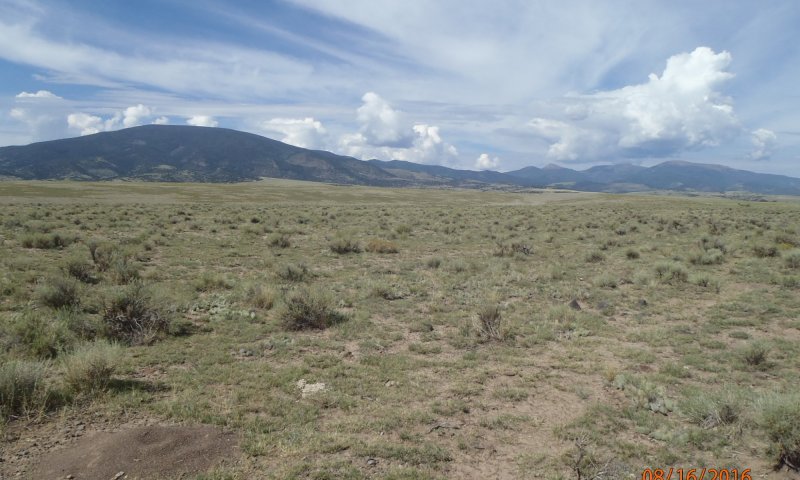
Figure 12. Increased bare ground, lower species diversity
Blue grama and Greene’s rabbitbrush have increased in percent composition of the site. Western wheatgrass, winterfat, and fourwing saltbush have decreased in percent composition, production, and vigor. Indian ricegrass and needleandthread have been reduced to remnant amounts. Sand dropseed, threeawn, and ring muhly have increased as well as snakeweed, rubber rabbitbrush, and pricklypear cactus. Annual forbs that are likely to begin invading this community consist of Russian thistle, kochia, tansy mustard, and lambsquarter.
Resilience management. This is considered an "at risk" community phase as ecological health as decreased. Plant species diversity and cover have decreased while bare ground as increased. As biotic integrity decreases important ecological components such as organic matter and aggregate stability decrease causing a net decrease in moisture retention for the site. As ecological integrity declines the site is at risk to crossing a threshold to a degraded state.
Dominant plant species
-
Greene's rabbitbrush (Chrysothamnus greenei), shrub
-
rubber rabbitbrush (Ericameria nauseosa), shrub
-
blue grama (Bouteloua gracilis), grass
Figure 13. Plant community growth curve (percent production by month). CO5102, Warm season dominant, cool season sub-dominant; MLRA-51; coarse textured soils.
| Jan | Feb | Mar | Apr | May | Jun | Jul | Aug | Sep | Oct | Nov | Dec |
|---|---|---|---|---|---|---|---|---|---|---|---|
| J | F | M | A | M | J | J | A | S | O | N | D |
| 0 | 0 | 0 | 2 | 15 | 25 | 30 | 20 | 8 | 0 | 0 | 0 |
Pathway 1.1A
Community 1.1 to 1.2


The main driver is grazing repeatedly throughout the growing season, often with high to moderate stocking rates. Preferred cool season species do not have the ability to recover and eventually decline in the system. Plants with greater defense mechanisms, such as low meristems (blue grama) and higher toxins (rabbitbrush), gain a competitive advantage. Overall range health is declining.
Pathway 1.2A
Community 1.2 to 1.1


Grazing management that leads toward restoration of cool season species. Plants such as Indian ricegrass, western wheatgrass, needleandthread, and winterfat gain in composition, vigor, and production. This means allowing rest during the critical growing season for these cool season species. It also includes monitoring and adaptive management to improve overall ecological site health.
State 2
Degraded
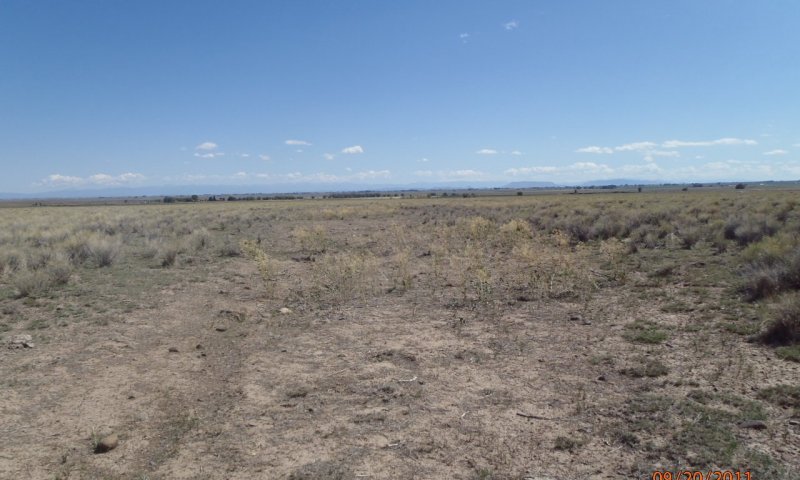
Figure 14. Bare ground is wide spread
This degraded state will have a predominance of bare ground, annuals, rabbitbrush species, ring muhly, and low vigor blue grama. Preferred cool season species are scarce and only exist in protected areas. Though squirreltail can hang on provide a stabilizing element in this state. This plant community develops through long-term continuous grazing. The consistent and persistent lack of adequate recovery periods between grazing occurrences has caused Greene’s rabbitbrush and/or rubber rabbitbrush to dominate. Overall production, plant vigor, species diversity, and frequency of all native vegetation has decreased dramatically. Litter levels are low and bare ground has increased. Flow paths are evident. Soil stability, biotic integrity, and hydrologic cycles are disrupted. It will take a long time to recover from this state.
Resilience management. The degraded state has low resilience to disturbance. With low biotic diversity and cover, critical soil health features such as moisture retention, mineralization, and decomposition have decreased to a level were ecological services are negligible.
Dominant plant species
-
rubber rabbitbrush (Ericameria nauseosa), shrub
-
ring muhly (Muhlenbergia torreyi), grass
Community 2.1
Warm Season Grass and Bare Ground
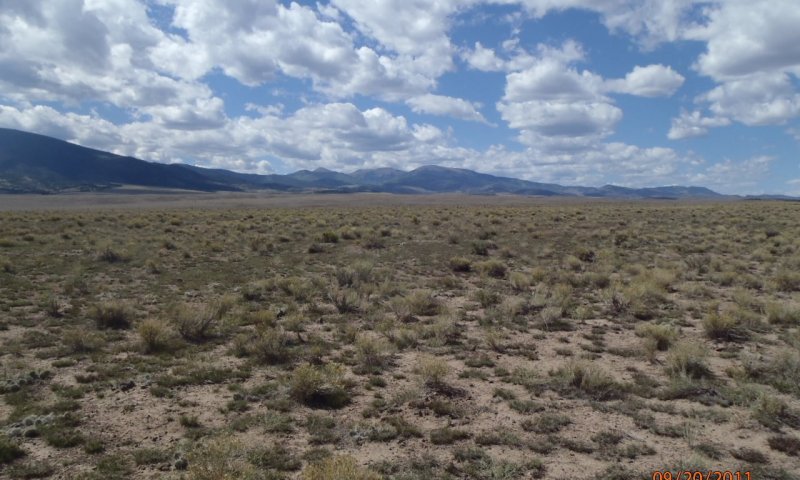
Figure 15. Ring Muhly-Blue Grama-Bare Ground
This community phase has crossed a threshold due to low species production and diversity and a high percentage of bare ground. Blue grama purple threeawn, and ring muhly are the key warm season grasses found on this community. Winterfat and fourwing saltbush have either been removed or are existing in extremely weakened condition. Squirreltail and western wheatgrass may be surviving within the protection of shrub canopy. Secondary grasses such as Indian ricegrass and needleandthread have been removed. Sand dropseed has the potential to increase. Higher successional forbs have decreased in frequency and production. Kochia, Russian thistle, kochia, lambsquarter, pepperweed, and tansymustard have substantially increased.
Resilience management. Resilience to disturbance is marginal. Fibrous root systems are shallow, bare ground is abundant, soil loss due to sheet erosion is evident, and evapotranspiration is high. Further disturbance and degredation will allow for die-off of perennial species and a site that is mostly bare ground and annuals.
Dominant plant species
-
ring muhly (Muhlenbergia torreyi), grass
-
blue grama (Bouteloua gracilis), grass
Community 2.2
Rabbitbrush Dominant
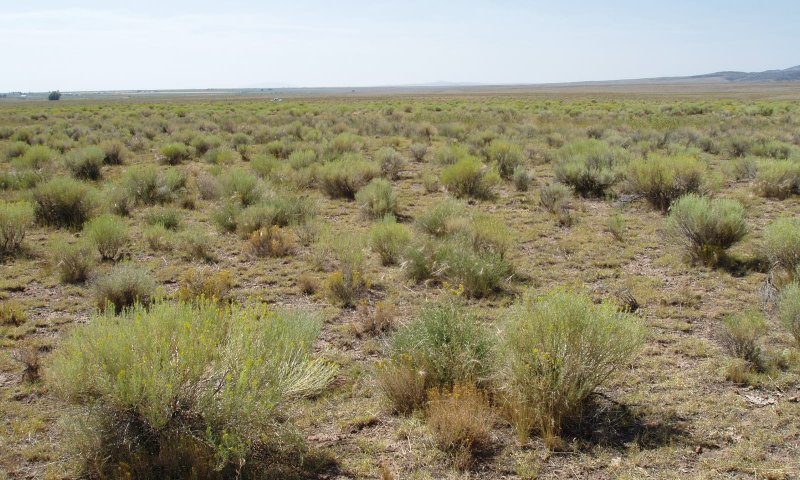
Figure 16. Rabbitbrush Dominant
This degraded community phase is rabbitbrush dominant with Green'es and rubber rabbitbrush. Over time warm season grasses such as blue grama and ring muhly will also occupy this community phase.
Dominant plant species
-
rubber rabbitbrush (Ericameria nauseosa), shrub
-
Greene's rabbitbrush (Chrysothamnus greenei), shrub
Pathway 2.1A
Community 2.1 to 2.2


To move to a rabbitbrush community there is usually a sign of past soil disturbance. This could be past plowing, grading, or excessive erosion.
Pathway 2.2A
Community 2.2 to 2.1


Overtime with long-term rest, rabbitbrush species will decrease in production and composition allowing blue grama and ring muhly to increase in composition. Bare ground has increased as well.
Transition T1A
State 1 to 2


The main driver leading to a threshold cross is long-term, repetitive, high utilization of plant species without recovery and opportunity for reproduction. High stocking rates increase the speed of this degradation. Essentially, preferred species get bitten repeatedly until above and below ground reserves are depleted and species die. Plants with greater defenses, such as blue grama with low meristems and weak rhizomes, and rabbitbrush with chemicals that repel taste and smell, continue to exist in in the degraded state. Bare ground increases, soil stability decreases, and the site loses its hydrologic function. Often a drought is the trigger event that causes the site to cross the threshold.
Restoration pathway R2A
State 2 to 1


To restore the site to reference conditions the soil must be stabilized and built to have higher resilience. This is a long term process where cover increases, organic matter increases, aggregate stability increases, infiltration increases, and biotic diversity and production increases. As a tool in the conservation toolbox, grazing management must include monitoring and adaptive management to give plants an opportunity to re-establish and slowly begin to repair the soil. Years of favorable precipitation are helpful to speed up progress.
Additional community tables
Table 6. Community 1.1 plant community composition
| Group | Common name | Symbol | Scientific name | Annual production (lb/acre) | Foliar cover (%) | |
|---|---|---|---|---|---|---|
|
Grass/Grasslike
|
||||||
| 1 | Grasses | 350–500 | ||||
| blue grama | BOGR2 | Bouteloua gracilis | 90–240 | – | ||
| squirreltail | ELEL5 | Elymus elymoides | 45–120 | – | ||
| Indian ricegrass | ACHY | Achnatherum hymenoides | 45–120 | – | ||
| western wheatgrass | PASM | Pascopyrum smithii | 45–120 | – | ||
| needle and thread | HECO26 | Hesperostipa comata | 30–80 | – | ||
| sand dropseed | SPCR | Sporobolus cryptandrus | 30–80 | – | ||
| purple threeawn | ARPU9 | Aristida purpurea | 15–40 | – | ||
| ring muhly | MUTO2 | Muhlenbergia torreyi | 3–8 | – | ||
|
Forb
|
||||||
| 2 | Forbs | 35–75 | ||||
| snowball sand verbena | ABFR2 | Abronia fragrans | 0–8 | – | ||
| bastard toadflax | COUM | Comandra umbellata | 0–8 | – | ||
| sulphur-flower buckwheat | ERUM | Eriogonum umbellatum | 0–8 | – | ||
| western wallflower | ERAS2 | Erysimum asperum | 0–8 | – | ||
| scarlet gilia | IPAG | Ipomopsis aggregata | 0–8 | – | ||
| narrowleaf stoneseed | LIIN2 | Lithospermum incisum | 0–8 | – | ||
| tanseyleaf tansyaster | MATA2 | Machaeranthera tanacetifolia | 0–8 | – | ||
| Colorado four o'clock | MIMU | Mirabilis multiflora | 0–8 | – | ||
| crownleaf evening primrose | OECO2 | Oenothera coronopifolia | 0–8 | – | ||
| locoweed | OXYTR | Oxytropis | 0–8 | – | ||
| sidebells penstemon | PESE11 | Penstemon secundiflorus | 0–8 | – | ||
| broom-like ragwort | SESP3 | Senecio spartioides | 0–8 | – | ||
| scarlet globemallow | SPCO | Sphaeralcea coccinea | 0–8 | – | ||
|
Shrub/Vine
|
||||||
| 2 | Shrubs | 75–150 | ||||
| fourwing saltbush | ATCA2 | Atriplex canescens | 45–120 | – | ||
| Greene's rabbitbrush | CHGR6 | Chrysothamnus greenei | 45–120 | – | ||
| rubber rabbitbrush | ERNA10 | Ericameria nauseosa | 45–120 | – | ||
| winterfat | KRLA2 | Krascheninnikovia lanata | 45–120 | – | ||
| plains pricklypear | OPPO | Opuntia polyacantha | 3–8 | – | ||
| skunkbush sumac | RHTR | Rhus trilobata | 3–8 | – | ||
| spineless horsebrush | TECA2 | Tetradymia canescens | 3–8 | – | ||
| soapweed yucca | YUGL | Yucca glauca | 3–8 | – | ||
| prairie sagewort | ARFR4 | Artemisia frigida | 0–8 | – | ||
| broom snakeweed | GUSA2 | Gutierrezia sarothrae | 0–8 | – | ||
Interpretations
Wood products
NA
Supporting information
Inventory data references
Location of Typical Example of the Site:
Along Gunbarrel Highway northwest of Capulin in Conejos County, between Alamosa Creek and the Rio Grande County line.
Field Offices in Colorado where the site occurs:
Alamosa, Center, and San Luis
References
-
. 2021 (Date accessed). USDA PLANTS Database. http://plants.usda.gov.
Other references
Chapman, S.S., G.E. Griffith, J.M. Omernik, A.B. Price, J. Freeouf, and D.L. Schrupp. 2006. Ecoregions of Colorado. (2-sided color posterwith map, descriptive text, summary tables, and photographs). U.S. Geological Survey, Reston, VA. Scale 1:1,200,000.
Cleland, D.T.; Freeouf, J.A.; Keys, J.E.; Nowacki, G.J.; Carpenter, C.A.; and McNab, W.H. 2007. Ecological Subregions: Sections andSubsections for the conterminous United States. Gen. Tech. Report WO-76D [Map on CD-ROM] (A.M. Sloan, cartographer). Washington,DC: U.S. Department of Agriculture, Forest Service, presentation scale 1:3,500,000; colored.
Soil Conservation Service (SCS). August 1975. Range Site Description for Limy Bench #276. : USDA, Denver Colorado.
United States Department of Agriculture, Natural Resources Conservation Service. 2006. Land Resource Regions and Major Land Resource Areas of the United States, the Caribbean, and the Pacific Basin. U.S. Department of Agriculture Handbook 296.
Contributors
S. Woodall, C. Villa
Approval
Kirt Walstad, 12/11/2024
Acknowledgments
Project Staff:
Suzanne Mayne-Kinney, Ecological Site Specialist, NRCS MLRA, Grand Junction SSO
Alan Stuebe, MLRA Soil Survey Leader, NRCS MLRA Alamosa SSO
Program Support:
Rachel Murph, NRCS CO State Rangeland Management Specialist, Denver
Eva Muller, Regional Director, Rocky Mountain Regional Soil Survey Office, Bozeman, MT
B.J. Shoup, CO State Soil Scientist, Denver
Eugene Backhaus, CO State Resource Conservationist, Denver
--Site Development and Testing Plan--:
Future work to validate and further refine the information in this Provisional Ecological Site Description is necessary. This will include field activities to collect low-, medium-, and high-intensity sampling, soil correlations, and analysis of that data.
Additional information and data are required to refine the Plant Production and Annual Production tables for this ecological site. The extent of MLRA 51 must be further investigated.
Field testing of the information contained in this Provisional ESD is required. As this ESD is moved to the Approved ESD level, reviews from the technical team, quality control, quality assurance, and peers will be conducted.
Rangeland health reference sheet
Interpreting Indicators of Rangeland Health is a qualitative assessment protocol used to determine ecosystem condition based on benchmark characteristics described in the Reference Sheet. A suite of 17 (or more) indicators are typically considered in an assessment. The ecological site(s) representative of an assessment location must be known prior to applying the protocol and must be verified based on soils and climate. Current plant community cannot be used to identify the ecological site.
| Author(s)/participant(s) | S. Woodall, C. Villa |
|---|---|
| Contact for lead author | |
| Date | 12/14/2004 |
| Approved by | Kirt Walstad |
| Approval date | |
| Composition (Indicators 10 and 12) based on | Annual Production |
Indicators
-
Number and extent of rills:
None to slight. If present, short and discontinuous and apparent following intense rainfall events. -
Presence of water flow patterns:
None, except following high intensity storms. Flow paths if present will be short (1-3 feet), with minimal evidence of past or current soil deposition. -
Number and height of erosional pedestals or terracettes:
Very minor, if present, terracettes may occur in flow paths following intense storms. -
Bare ground from Ecological Site Description or other studies (rock, litter, lichen, moss, plant canopy are not bare ground):
5% or less bare ground, with bare patches generally less than 3-5 inches in diameter. Extended drought can cause bare ground to increase upwards to 5-10% with bare patches reaching upwards to 6-10 inches in diameter. -
Number of gullies and erosion associated with gullies:
None -
Extent of wind scoured, blowouts and/or depositional areas:
None -
Amount of litter movement (describe size and distance expected to travel):
Litter movement is minimal and short (6-12 inches). -
Soil surface (top few mm) resistance to erosion (stability values are averages - most sites will show a range of values):
Stability class rating anticipated to be 4-5 in the interspaces at soil surface. -
Soil surface structure and SOM content (include type of structure and A-horizon color and thickness):
Surface soil textures range from gravelly sandy loam, cobbly sandy loam, very gravelly sandy loam, very gravelly loam, and cobbly loam. The A-horizon is light brownish gray that can extend from 4 to 16 inches thick. Structure is typically weak medium granular, moderate fine granular structure or weak fine granular structure. -
Effect of community phase composition (relative proportion of different functional groups) and spatial distribution on infiltration and runoff:
Diverse grass, forb, shrub canopy and root structure reduces raindrop impact and slows overland flow providing increased time for infiltration to occur. Extended drought reduces grass, forb, and shrub production causing decreased infiltration and increased runoff following intense storms. -
Presence and thickness of compaction layer (usually none; describe soil profile features which may be mistaken for compaction on this site):
None -
Functional/Structural Groups (list in order of descending dominance by above-ground annual-production or live foliar cover using symbols: >>, >, = to indicate much greater than, greater than, and equal to):
Dominant:
shrubs >Sub-dominant:
warm season bunchgrass > cool season bunchgrass = cool season rhizomatous >Other:
forbsAdditional:
-
Amount of plant mortality and decadence (include which functional groups are expected to show mortality or decadence):
Minimum. Expect some natural mortality and decadence on bunchgrasses and shrubs. -
Average percent litter cover (%) and depth ( in):
10-20% litter cover at 0.25 inch depth. Litter cover during and following extended drought ranges from 5-10%. -
Expected annual annual-production (this is TOTAL above-ground annual-production, not just forage annual-production):
250 lbs./ac. low precip years; 550 lbs./ac. average precip years; 850 lbs./ac. above average precip years. After extended drought, production will be significantly reduced to 200 – 400 lbs./ac. or more. -
Potential invasive (including noxious) species (native and non-native). List species which BOTH characterize degraded states and have the potential to become a dominant or co-dominant species on the ecological site if their future establishment and growth is not actively controlled by management interventions. Species that become dominant for only one to several years (e.g., short-term response to drought or wildfire) are not invasive plants. Note that unlike other indicators, we are describing what is NOT expected in the reference state for the ecological site:
None -
Perennial plant reproductive capability:
The only limitations are weather-related, natural disease, inter-species competition, wildlife, and insects that may temporarily reduce reproductive capability.
Print Options
Sections
Font
Other
The Ecosystem Dynamics Interpretive Tool is an information system framework developed by the USDA-ARS Jornada Experimental Range, USDA Natural Resources Conservation Service, and New Mexico State University.
Click on box and path labels to scroll to the respective text.